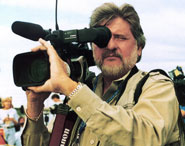|
|
Welcome to the March issue of The Digital Journalist, the monthly online magazine for visual journalism.
This month we continue our redesign, started last month. From now on, we will be presenting HD videos prominently in our features. Last month we conducted two nine-day Platypus Workshops, the first for the Houston Chronicle, which we held on-site. We then moved on to New Orleans for our first scheduled workshop of the year. New Orleans probably was the best venue we ever had. As one of our participants said, "If you can't find stories here, you shouldn't be in the business!"
In our main feature section we present the prize-winning videos produced by the workshop students. They are compelling video pieces, better than you are used to seeing on TV. Some will make you cry. They are stories about real people, far away from the daily headlines. We feature them in full HD, with our Vimeo server. We recommend them to you.
Our cover story is the recent book, "McClellan Street," by our past contributors, renowned photojournalists David and Peter Turnley. This is a project that they started when they were still in high school in Fort Wayne, Ind. It was this body of work that David Turnley (Peter was laid up with a knee injury at the time) took to New York to show agents that started their remarkable careers. A classic example of documentary photography, "McClellan Street" is a look back at a much simpler time in America, and we know you will enjoy it.
Earlier this year, a treasure trove – a suitcase full of negatives by Robert Capa, his lover/collaborator Gerda Taro and David "Chim" Seymour that had been missing for 56 years – found a permanent home at the International Center of Photography following years of negotiations. Our Ron Steinman places these found negatives – "the Holy Grail of Robert Capa's work" – into historical context, and investigates "when the world would be privy to the guts of the discovery."
Louis P. Masur has written an essay about what happened after Stanley Forman won his Pulitzer Prize for his photograph of a white man attacking a black man with the American flag in Boston in 1976. It is an excerpt from his book "The Soiling of Old Glory: The Story of a Photograph That Shocked America."
As of this month, we are adding an Education column to our issues, written by David Lyman, the founder of The Maine Photographic Workshops. They draw on his remarkable career as an educator, and moving force in photography.
In March we present four timely Dispatches that span the brutal to the beautiful. Both Danfung Dennis and Alex MacNaughton look at the bloody confrontations in Kenya. Derek Flood was in Pakistan for the recent elections and Lisa O'Connor hurried and waited, hurried and waited to photograph the Oscars.
E-Bits editor Beverly Spicer remembers the old days of Life, Look, and The Saturday Evening Post, and reflects on how times are changing. She also tells the story of the birth of E-Bits.
In this month's Assignment Sheet, Eileen Douglas asks our collective conscience this question: "Friend or Foe?" The question is also asked of the people we cover in the news. Based on her experience as a journalist, Douglas examines the interplay between the media and the people we photograph and write about. How do they regard us? Friend? Foe? And, ultimately, how does that translate into how the newsmaker does his or her job? Retired Newsday Staff Photographer Dick Kraus has "An Unsolicited Opinion" about the trend in journalism these days: Are we destined to read all of our news from a backlit screen? Does anybody care?
In our "Camera Corner," Chick Harrity contributes an in-depth review of Nikon's D3, "the first full-frame camera with a 36 X 23.9mm CMOS sensor that produces amazing quality images from ISO 200 to IS0 6400." His conclusion? "I have to think the D3 is the best pro camera that Nikon has ever made and I have used them all, starting with the original F way back in 1959."
Our reliable columnists, Chuck Westfall and Mark Loundy and are back again this month with their diverse columns, along with Bill Pierce's Nuts & Bolts, which chronicles his love/hate relationship with Leica. Also this month, Jim Gabour writes again about life in post-Katrina New Orleans. And our Ethics columnists, Karen Slattery and Mark Doremus, tell the story of an honorable news director who paid the price for his integrity at his TV station.
TWO ANNOUNCEMENTS:
Our next Platypus Workshop will be May 23-June 1 in Ventura, Calif., at the Pierpont Inn. The conference and housing will be at the same great venue where most of our California Platypus classes have stayed in the past. In addition, we are in the process of planning two additional classes that will follow the workshop. On June 2-4, we will be conducting a special two-day multimedia workshop taught by PF Bentley that is essential for those who want to integrate their still and video into Web productions.
That weekend, from June 5-7, Chuck Braverman will conduct the new "Platypus Production Seminar." This is an advanced seminar in which Chuck, one of the best documentary producers in television, will teach the real nuts-and-bolts of how to make a living as a Platypus.
Subjects that will be covered include: • Current documentary status in: --------- Broadcasting --------- Cable --------- Internet • Different kinds of docs • Kinds of doc filmmakers • Process of Producing a Documentary: --------- Development --------- Pre-Production --------- Production --------- Formats • Post Production: --------- Offline vs. online --------- Dealing with HD Sales: --------- Distribution
We will post this schedule and contact information in the days ahead. Future workshops are filling up quickly. We recommend you register soon to avoid disappointment. A reminder: we give 10% discounts to NPPA and ASMP members.
We hope you enjoy this issue. Dirck Halstead |

